Have you ever thought that your blog could bring more leads and sales for your SaaS business? When you’re investing a lot of effort into writing high-quality content for your SaaS blog, you want it to become a revenue-generating machine. However, after some time you could notice that the incoming traffic doesn’t convert into new trials and sales at the rate you would expect.
In this article, I’m showing you seven killer blog optimization strategies for SaaS that will help you generate more leads and sales from your blog and gain more benefit from content marketing activities:
- Track your blog conversion rate
- Connect your SaaS funnel
- Show your tool in action
- Quit traditional lead magnets
- Experiment with CTAs
- Use chatbots to guide users
- Focus on the best-performing traffic sources
1. Track your current blog conversion rate
You can’t improve what you can’t measure. That is why before you get into optimizing content, you need to find out where you are standing with conversions. Moreover, instead of just quickly checking goal conversion rates in your Google Analytics account, you should consider creating some dashboard that visualizes data for you. This way, you can see how the new tweaks affect conversion rate on a daily basis.
You can consider creating a dashboard in Google Analytics that would show you key conversion data or, alternatively, integrate the analytics data with a third-party tool that can support you with a better data visualization for your content analytics, like Databox or Geckoboard.
Here is an example of such a dashboard. Databox was able to use Google Analytics for blog metrics.
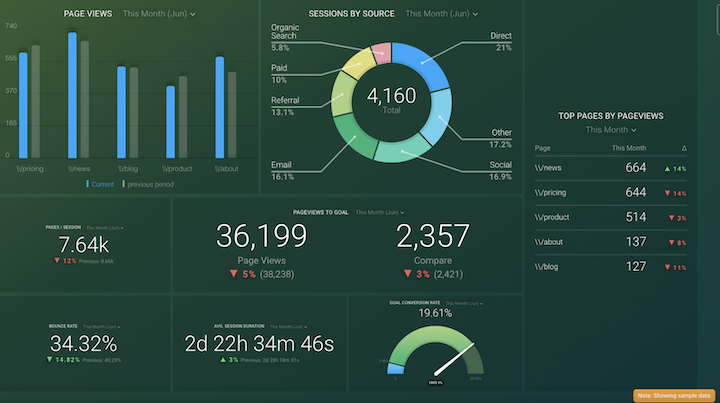
When preparing your dashboards, make sure you set up all goals that will help measure blog content performance. For example, one of the most crucial goals could be signing up for a free trial or registration for a free or paid account.
What if your blog posts are not the spot where conversion happens, a.k.a. your landing pages? Let’s say your page visitors land on your blog post to later visit multiple other pages before making a decision to sign up for a free trial.
In this case, you shouldn’t only be measuring last-click conversion (goal completion on the page where conversion takes place). Also, consider attributing a conversion to the first click (the page where your lead has visited your website for the first time).
That is where Google Comparison tool can come in handy as it helps you compare conversions across different attribution models (for example, last click or first click). Google Analytics is more than enough to dive into the statistics if you’re working within a startup marketing budget.
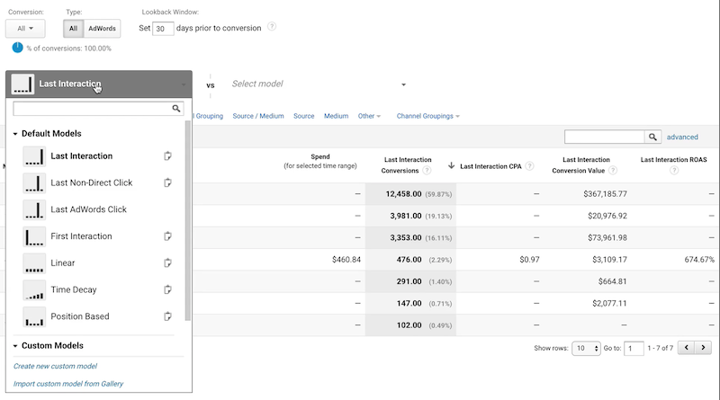
Source: Google Analytics Model Comparison Tool.
There is definitely much more to this topic and additional tools you can use, like Google Search Console, for even more data. For now, start with understanding your key metrics and goals—you can drill deeper into the topic while assembling your analytics panels. So let’s move forward to the next tip!
2. Connect your SaaS funnel
To get your landing page visitor and a potential client sign up for a free trial or pay a subscription fee, you have to direct them to the right place after they have already learnt about the solution to their problem.
Use CTAs to lead down the funnel
Check out how SalesHandy is integrating smart CTAs that relate to the content of the blogpost section or subheadings.
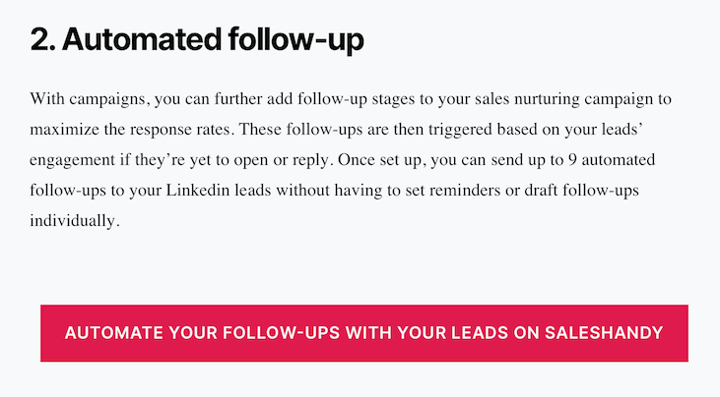
You’d imagine that more specific and targeted CTAs would result in more clicks compared to generic buttons or banners that contain a “Start your trial” call to action.
Stand out with banners
Break out your blog post text with a few banners—at best they should relate to the specific context of a blog post section. Check if your content management system, or CMS, allows to dynamically modify banner elements, such as header, subheading, CTA text and an image to free up time for you or your designer to create custom images in visual editors.
Here is how Devskiller, a SaaS tool for interviewing developers, integrates a banner with a final CTA after each article.

Add converting elements in your sidebar space
Use your blog space wisely by integrating a sign-up form in your sidebar widget. This can be to sign up for your email list or product. This area is especially important for conversions because one can make sidebar widgets sticky on scroll. As a result, when someone reads a blog article, a banner or a sign-up form in the sidebar widget doesn’t disappear—it’s there for users to click at.
Check out how it looks on this blog on marketing for SaaS.
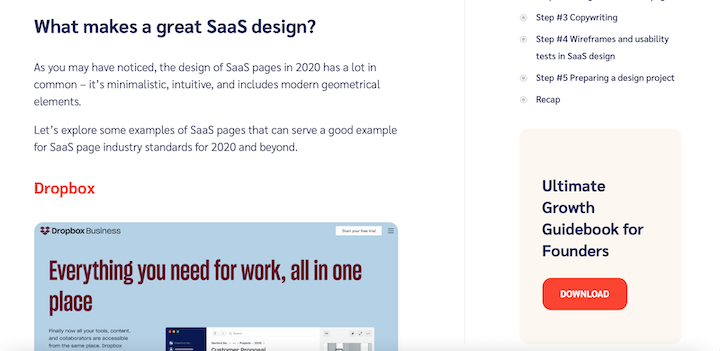
3. Show your tool in action
When writing your articles on more general topics, you might end up attracting wrong traffic that has a low chance to convert into paying users. Brainstorm your new content ideas wisely and consider how the topics are aligned with your product and target audience. It can be helpful to find your own niche and to ask yourself this question: Will the topic give space to show my product in action?
Here is how Hotjar is demonstrating their product in the article about rage clicks. Rage clicks are accidental user clicks in selected page areas that signal UX issues or frustration with page elements.
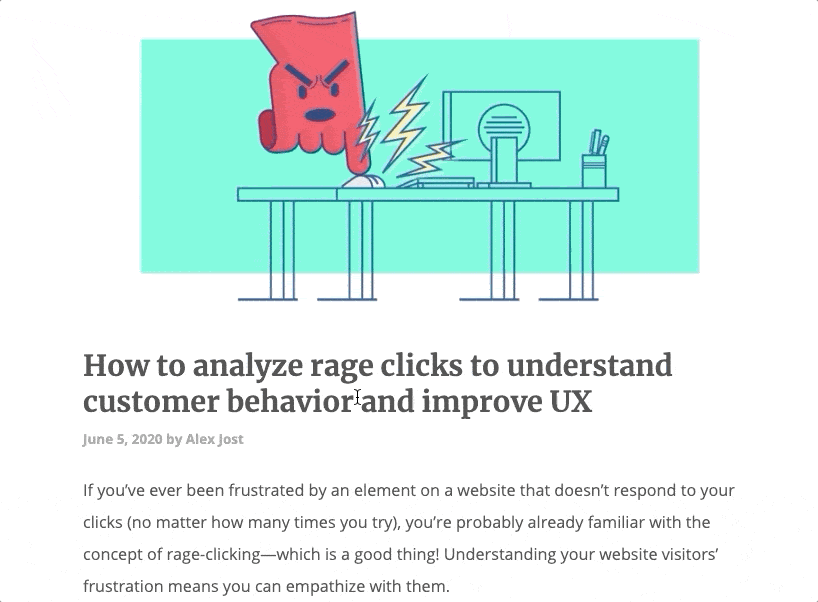
While Hotjar’s article about rage clicks explains how to use session recordings to find out the reason behind rage clicks and improve UX, they give multiple examples of how their product can help resolve the problem. They add some GIFs and images that illustrate the process and make it clear for a reader.
I’ll guess here: You would probably test their tool while looking for a solution to a problem of rage clicks if you are a UX designer.
That is why Hotjar is later encouraging readers to try out the tool for free using banners, buttons, or contextual links. This is an effective tactic for them.
Quick tip: When writing new blog posts or starting optimizing SEO (Search Engine Optimization) for existing blog posts, focus on those with higher buyer intent. One of the ideas for attracting visitors who can be ready to buy your SaaS product can be a tools comparison list. You can add your tool to the list and encourage signing up for a demo or free trial—just be objective and avoid sounding overly promotional!
4. Quit traditional lead magnets
Don’t expect page visitors to figure out their way to converting into users on their own—guide them with the right incentives. For example, if your SaaS offers some templates, use them as a lead magnet. This way, you can simultaneously sign up your page visitors for a newsletter or free trial while offering some quick wins and instant value.
You don’t have to write a long guidebook and gate it asking for lots of personal information. It can take longer to convert a blog reader who has downloaded some PDF compared to offering a downloadable template.
5. Experiment with CTAs
Try tweaking your CTA a bit to get more engagement more often. Instead of more generic “Download” or “Sign up” buttons, offer a different one that clearly states the value for a reader. For example, if you are offering cover letters or CVs in a subscription model use the following CTAs: “Create a winning cover letter,” or “Start building your CV now.” Experiment with more actionable CTAs that can lead to a higher conversion.
Check out how EnhanceCV is doing it with their cover letter examples.
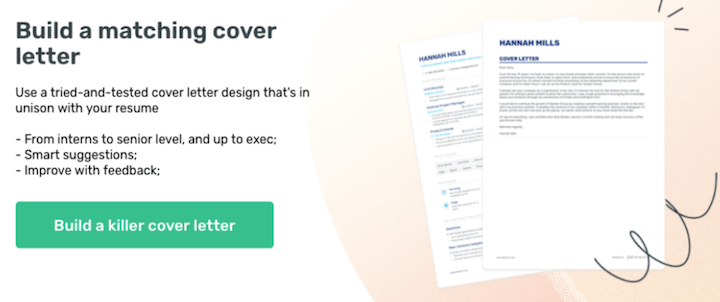
If you are not sure about the impact of your new CTAs, create A/B tests and validate your hypothesis about new word combinations. Google Optimize is a tool you can use to test CTAs and other elements, and if you’re an Unstack user, you have access to A/B testing and analytics built right into the platform.
6. Use chatbots to guide users
When your page visitor has finally reached a point when they subscribe for a free trial through one of your sign up forms, your next pain appears—bounce rate. There are at least two reasons why website visitors decide to quit a sign up form. According to the Manifest study, 29% of visitors churn due to security concerns related to sign-up forms, while 27% due to a long and complicated process of filling in form fields.
Should you collect less data in your sign up form to boost your form conversion rates? Possibly! However, in some cases, you have no fields to reduce as they can seem equally important to you.
Good news! You can collect trial signups with chatbots as they offer a more seamless way of inputting user data: through a conversation.
Instead of overwhelming your users with excessive fields to fill out before they start enjoying their free trial, you can make the whole process more engaging and fun by adding a chatbot window.
Before jumping in headfirst, test it out. Introduce them on your website, set smart trigger rules to match a visitor’s context, and check if they have an impact on your conversion rate. I bet they will!
Moreover, with an array of user-friendly chatbots available, user experience should not be your concern—most solutions will fulfill their purpose without distracting a reader.
7. Focus on the best performing traffic sources
No matter how much effort you are putting into blog optimization, you can’t expect a lot to change if you are driving poor website traffic.
That is why it's important to check out the conversion rate for each traffic channel to identify the best-performing ones. For example, you could notice that organic search traffic and the traffic coming from your referral programs is driving the most conversions.
Focus on your winners! Invest more effort into increasing blog traffic coming from these channels. Also, you can consider personalizing your banners and dynamically displaying them depending on where your traffic comes from. This should help improve conversions while optimizing content.
Use these tips to convert more blog traffic
Generating more leads from your blog posts requires a lot of investment in content optimization. If you decide to do things as you have used to do them in the past, don’t expect any changes to happen. Most likely, more blog articles will not affect your organic traffic or the rate at which your new visitors convert on the website.
That is why you have to take a step back and rethink the blog post performance and your content strategy. In this article, you have seen how different optimization ideas and resources can help you move your page visitors down the marketing funnel and generate more conversions.
Now, it is time to act on this knowledge and set up your SaaS blog optimization strategy. Good luck!
About the author
Margo Ovsiienko is a growth marketing partner for tech companies. She creates content that converts website visitors into paying customers for B2B/SaaS companies with digital marketing funnels. Get in touch with Margo on her blog, Margo Leads, or LinkedIn.
